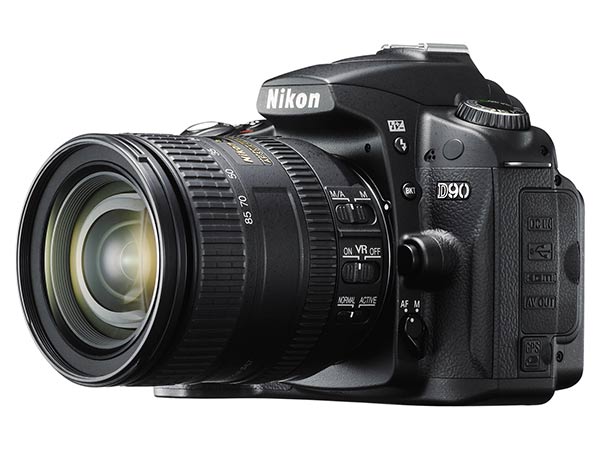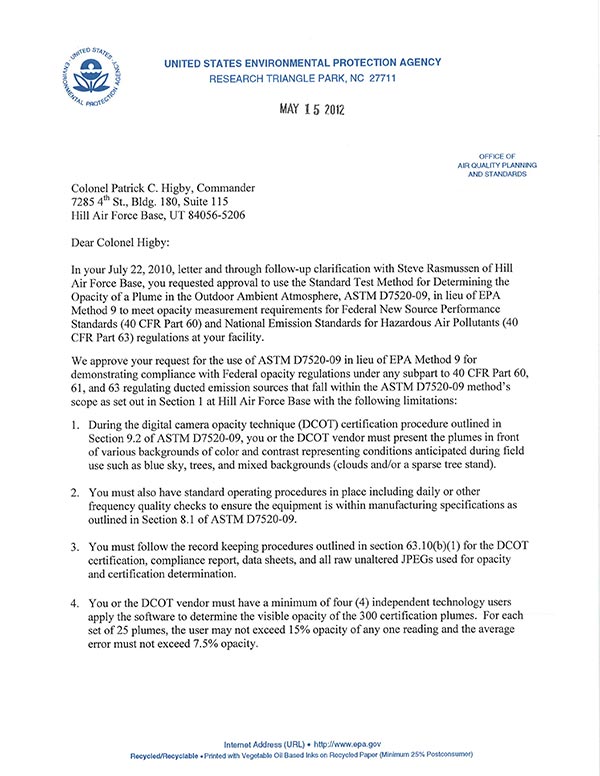EPA Alternative Method ALT-082 was approved in 2011 as an alternative test method to EPA Method 9. ALT-082 is a letter that adds limitations to ASTM D7520. ASTM D7520 is a test protocol to determine the opacity of visible emissions using a digital camera. It is also known as the Digital Camera Opacity Technique or DCOT. Essentially, ALT-082 allows ASTM D7520 to be used as an alternative to Method 9 provided some requirements are met.
ASTM D7520 is the basis of ALT-082 so we’ll start with it. D7520 specifies the use of a digital camera, analysis software and output function. Together, these items are known as the Digital Camera Opacity Technique (DCOT). A DCOT operator collects the data using the DCOT and analyzes the images produced using software. Here are some notes on the use of the DCOT.
- All observation principles established by Method 9 must be adhered to when using the DCOT. The only difference is that the operator uses the camera to record the reading.
- A DCOT configuration must be certified every 3.5 years. To be certified, the DCOT must pass six runs at a smoke school within 6 months.
- A DCOT operator must be trained in the Principles of Visible Emissions (smoke school lecture).
- A DCOT operator must complete a training course specified by the DCOT manufacturer.
- Opacity readings are not instant when using a DCOT. The images are sent to a third party for analysis.
- The DCOT is not applicable to sources with stacks which have an internal diameter greater than 7 feet.
 A digital camera captures the data for EPA ALT-082 and is then sent to a third-party for image analysis.
A digital camera captures the data for EPA ALT-082 and is then sent to a third-party for image analysis.
This alternative test method to Method 9 incorporates ASTM D7520 with the following restrictions:
- Only approved to demonstrate compliance with Federal opacity limitations. Does not approve to demonstrate compliance with state or municipal opacity limitations.
- Requires the DCOT configuration be certified with various backgrounds such as blue skies, trees and heterogeneous backgrounds.
- Requires a standard operating procedure including quality checks for the DCOT.
- The DCOT certification procedure must be performed by four independent users.
- Opacity readings are not instant when using a DCOT. The images are sent to a third party for analysis.
AeroMet has strived to bring smoke school into the 21st century by introducing this online lecture course and our computer-controlled smoke generators. We feel a DCOT system could be a great application for the regulatory community, especially with its ability to record plume readings as evidence. At the time of this writing, there is only one commercially-available DCOT system. As with any new system, it has limitations and problems which must be addressed.
- Accuracy. The current system has been tested and found inaccurate for mixed backgrounds (trees, clouds, etc.). Even with consistent backgrounds, there are problems with accuracy and consistency. Here is a memo from the Virginia Department of Environmental Quality describing their 2012 test of the DCOT system.
- Analysis. Although D7520 intended for users to be able to perform analysis of their images, the current software is too technical and requires all images to be sent to a third-party for analysis. This process can take days or weeks to obtain results.
- Insufficient Data. Because the DCOT operator must send the images to a third-party, the operator will not know if the data collected was acceptable until the analysis is performed.
- Time. A DCOT operator must control the camera during the observations, report the conditions of the test, upload the images to a computer, transfer the images to a third-party, have the images analyzed and then wait for the report. As the DCOT currently exists, the ability to quickly determine opacity limit violations is lost.
- Cost. The DCOT operator must complete a training course to operate the camera and also purchase an approved camera model. They must also purchase an annual software agreement which ranges from $1000-$5000/year. Analysis of the images, which must be submitted to a third-party, is charged in addition to the software subscription.
- Limitations. The DCOT cannot be used on stacks larger than 7 feet (internal diameter). It should not be used with poor-contrasting backgrounds or mixed backgrounds.






